|
Report
from
Europe
Stasis in EU tropical hardwood imports in 2014
The latest Eurostat trade data to end October 2014 shows
that tropical hardwood imports into the EU last year were
only marginally better than the historically low levels
recorded in the previous two years.
Various factors account for this lack of import growth
including lacklustre performance of the construction and
joinery sectors in much of Europe during 2014, supply
constraints and logistical problems (particularly for
shipments out of Douala port in Cameroon), and the EU
Timber Regulation which has encouraged buyers to focus
on a more limited range of tropical suppliers in order to
meet the VPA due diligence requirements.
Total EU28 imports of all the main timber products from
tropical countries were 3.63 million cu.m in roundwood
equivalent (RWE) terms in the first 10 months of 2014,
1.3% greater than the same period in 2013.
In value terms, EU tropical timber imports in the first ten
months of 2014 were euro1.18 billion, only 0.7% greater
than the same period the previous year.
The volume of EU imports of tropical sawn wood,
veneers, mouldings, glulam and flooring all increased
slightly in the first 10 months of 2014. However there was
a decline in EU imports of tropical plywood and logs
(Chart 1).
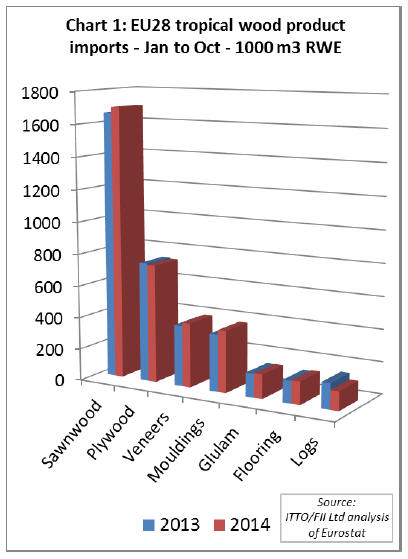 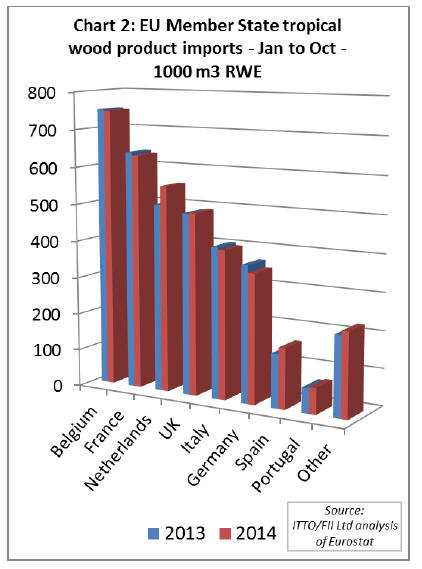
Total tropical hardwood imports into most EU countries
remained fairly static at low levels between 2013 and 2014
(Chart 2). There were slight gains in a few countries
including the Netherlands, Spain, Portugal and the UK, but
these were offset by declines in Germany and Italy.
Belgium an important transit country
In the first ten months of 2014, the volume of tropical
wood product imports into Belgium fell very slightly (-
0.5%) to 748,000 cu.m RWE.
Belgium‟s domestic market for tropical hardwood was
very slow last year, but any weakness at home was offset
by a rise in Belgium‟s re-exports of tropical hardwood
products to neighbouring countries.
Belgium‟s re-exports to other EU countries of all wood
products identified as containing tropical wood was
251,000 cu.m RWE in the first 10 months of 2014, 12%
more than the same period in 2013. Most of this volume
was destined for France, Netherlands and Germany.
Increased flows of tropical wood through Belgium
suggests a continuing trend towards concentration of trade
in a smaller number of larger importers close to the major
ports.
In part this reflects much tighter control of stock levels by
merchants and manufacturers who prefer to buy small but
regular volumes of mixed containers.
To some extent this trend is being reinforced by EUTR
which may be seen as another reason to avoid buying
direct and instead rely on timber placed on the EU market
by larger companies.
Weak construction depresses French imports
Direct imports of tropical wood into France were 632,000
cu.m RWE in the first ten months of 2014, 1.2% less than
previous year. The decline was partly due to the
continuing weakness in the French construction sector last
year.
Already slowing in the first half of 2014, output in
France's construction sector contracted a further 0.6% in
the three months to November according to the latest data
from INSEE.
Tropical hardwood plywood has also come under rising
competitive pressure in France from imported Chinese
plywood, European birch plywood, and other panel
products.
Imports of sawnwood into France from Cameroon fell
particularly dramatically last year. However there was a
rise in French veneer imports from Gabon, encouraged by
the EU‟s decision to suspend the GSP tariff on okoume
veneer from Gabon on 24 June 2014 and to backdate the
suspension to 1 January 2014.
Netherlands tropical wood imports rise 10%
In contrast to France, the volume of tropical hardwood
imports into the Netherlands increased 10% in the first ten
months of 2014.
Improving construction activity led to a particularly sharp
increase in Netherlands imports in the first two quarters of
2014. However the rate of growth slowed in the third
quarter of the year.
Demand for hardwoods in the Netherlands has benefitted
from the temporary VAT reduction on renovation
activities implemented since early 2013. This is now due
to remain in place until 30 June 2015 in an effort to offset
continuing challenges in the Netherlands housing sector.
Recognition of the Malaysian Timber Certification System
since October 2013 alongside other PEFC systems and
FSC for Dutch government procurement may well have
boosted imports of tropical hardwood into the Netherlands
last year.
In the first ten months of 2015, Netherlands imports of
Malaysian timber products were 246122 cu.m RWE, up
nearly 40% compared to the same period in 2013.
Slowing growth in UK tropical hardwood imports
After a sharp rise in the first six months of 2014, the rate
of growth in UK imports of tropical hardwood slowed in
the third quarter of the year.
Overall, UK imports of tropical hardwood products were
490,000 cu.m RWE in the first ten months of 2014, up
only 0.4% compared to the same period in 2013.
The slowing pace of UK tropical hardwood imports was
not due to any significant decline in the UK hardwood
market. UK hardwood distributors remained very busy in
the second half of 2014 driven by the on-going recovery in
construction.
However Chinese Mixed Light Hardwood plywood was
taking a rising share of the UK market during 2014,
largely at the expense of tropical hardwood plywood from
Malaysia.
UK tropical hardwood demand also remains very heavily
oriented towards sapele, with very little interest being
shown in lesser known or secondary species. As a result
the UK struggled to obtain adequate supplies, particularly
with the slow movement of goods through Douala port in
Cameroon during 2014. This encouraged some increased
interest in Malaysian meranti in the UK last year.
Sales of chemically and thermally modified wood products
have also been rising in the UK, taking share from tropical
hardwood.
Tropical wood regains some share in Italian market
Italian imports of tropical hardwood imports fell only
slightly in 2014 despite evidence of a continuing sharp
downturn in construction and other economic activity.
Overall Italy imported 400,000 cu.m RWE of tropical
hardwood products in the first ten months of 2014, only
1.7% less than the same period in 2013.
However this is hardly cause for celebration after seven
years of near continuous decline in Italian tropical
hardwood imports (from over 1.4 million cu.m RWE in
2007).
The relative stability in Italian imports in 2013 and 2014
despite continuing contraction in end-use sectors is partly
due to tropical hardwood reclaiming some of the share lost
to US hardwoods, particularly in the mouldings sector, as
prices of the latter have risen. This boosted Italian imports
of sawn wood from Gabon and Ivory Coast in 2014.
Italian timber merchants and manufacturers have also
increased sales into other parts of Europe. For example EU
internal trade data indicates that Italy‟s exports of tropical
hardwood plywood to other EU countries increased from
55,000 cu.m in the first ten months of 2013 to 63500 cu.m
in the same period in 2014, most destined for Germany,
Netherlands and France.
Indonesian wood products fare well in Germany
Imports of tropical hardwood products into Germany were
348,000 cu.m RWE in the first ten months of 2014, down
5.2% compared to the same period in 2013.
After two years of robust growth, Germany‟s construction
sector contracted during 2014. Germany‟s imports of
tropical sawn hardwood declined from all four the
country‟s largest suppliers ¨C Malaysia, Ghana, Cameroon
and Ivory Coast.
However, at least one tropical supply country fared well in
Germany last year. German imports of Indonesian
plywood, S4S sawn lumber, mouldings, veneers and
flooring components all increased in 2014.
This may be at least partly due to mandatory SVLK
certification of Indonesian products. Implementation of a
tough EUTR inspection regime in Germany and the
government‟s decision to confiscate a consignment of
African wenge logs due to an alleged breach of the law,
have sensitised importers to the need for legally verified
timber.
Pick up in Spanish and Portuguese imports
After several years of contracting demand, there was a
pick-up in demand for tropical hardwood products in
Spain and Portugal in the first 10 months of 2014.
In RWE terms, imports into Spain were nearly 12% higher
than the same period the previous year, while imports into
Portugal were 5% higher. This is an encouraging sign that
the painful structural reforms imposed by both countries in
the wake of financial crises are beginning to stimulate
more economic activity.
Although Spain‟s imports of tropical hardwood from
Cameroon fell last year, the country was importing more
from Ivory Coast, Brazil, Gabon and the Congo countries.
Portugal was importing more from Brazil in 2014.
Spain‟s tropical hardwood imports consist primarily of
sawn wood and veneers, whereas Portugal imports mainly
tropical sawn wood with a declining volume of logs.
EU tropical hardwood log imports slide even further
EU imports of tropical hardwood logs were 119,000 cu.m
in the first ten months of 2014, 25% less than the same
period of 2013. Imports fell particularly dramatically from
the Democratic Republic of Congo, down 43% at 27,000
cu.m in the first 10 months of the year (Chart 3).
Analysis of monthly data indicates that while the general
trend in EU imports of tropical logs has been downwards
over the last 3 years, there was a sharp increase in imports
in September and October 2014.
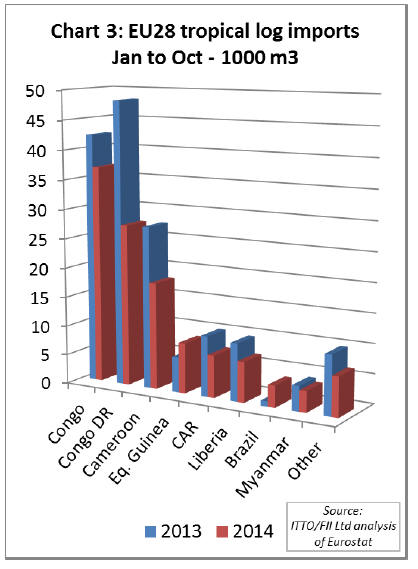 
Minor recovery in EU imports of sawn tropical
hardwood
EU imports of sawn tropical hardwood were 806,000 cu.m
in the first 10 months of 2014, 2% more than the same
period in 2013. Imports from Cameroon fell 9% to
247,000 cu.m (Chart 5).
However, this decline was offset by rising imports from
Malaysia (+11% to 161,000 cu.m), Brazil (+11% to
90,000 cu.m), Gabon (+7% to 81,000 cu.m), Ivory Coast
(+13% to 73,000 cu.m) and the Republic of Congo (+14%
to 39,000 cu.m).
Monthly data indicates that after a slow start to 2014, EU
imports of sawn hardwood increased strongly between
March and June (Chart 6). Imports fell away again in third
quarter of 2014 as consumption had not kept pace with
imports and European stocks had begun to build.
However there was a slight uptick in EU imports in
October 2014, mainly because wood at last began to flow
more freely from Cameroon. This followed introduction of
emergency measures by the Cameroon authorities to
reduce serious congestion at the port. These measures
included commissioning of new cranes and the allocation
and redevelopment of more transit space for timber
shipments.
Looking forward, port congestion is widely expected to
become less of a problem in Cameroon following the
recent announcement by the Minister of the Economy,
Planning and Regional Development that the Limbe Deep
Seaport supported by South Korean investment should
become operational during 2015.
The Kribi Seaport in Cameroon, supported by US$567
million of Chinese investment, is also reported to be 60%
complete and is expected to provide a large new harbour
serving all of Central Africa.
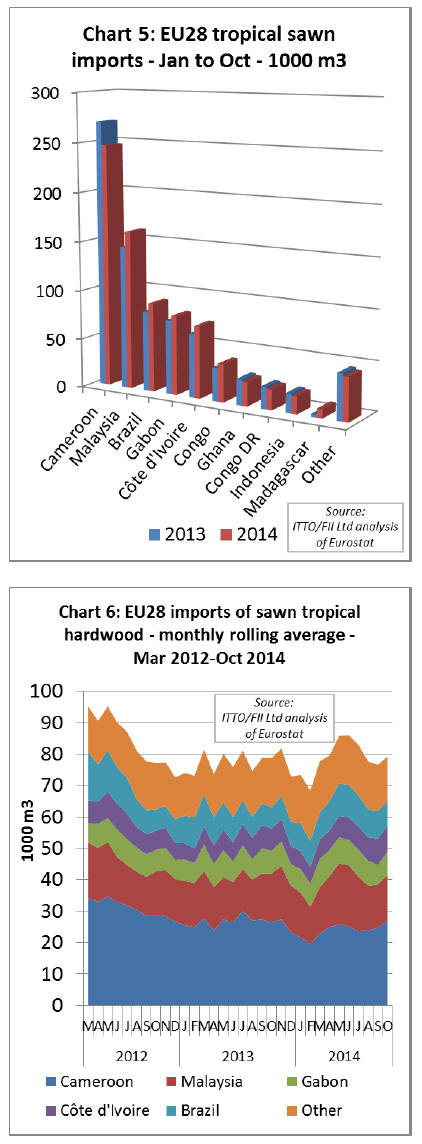
Strongerr EU demand for Asian decking in 2014
EU imports of tropical hardwood mouldings and decking
in the first 10 months of 2014 were 385,000 cu.m, 8%
more than the same period in 2014.
Imports from Indonesia during the period were 171,000
cu.m, a 20% gain on 2013 (Chart 6). Imports from
Malaysia also increased 34% to 33,000 cu.m. However
imports from Brazil declined 2% to 120,000 cu.m.
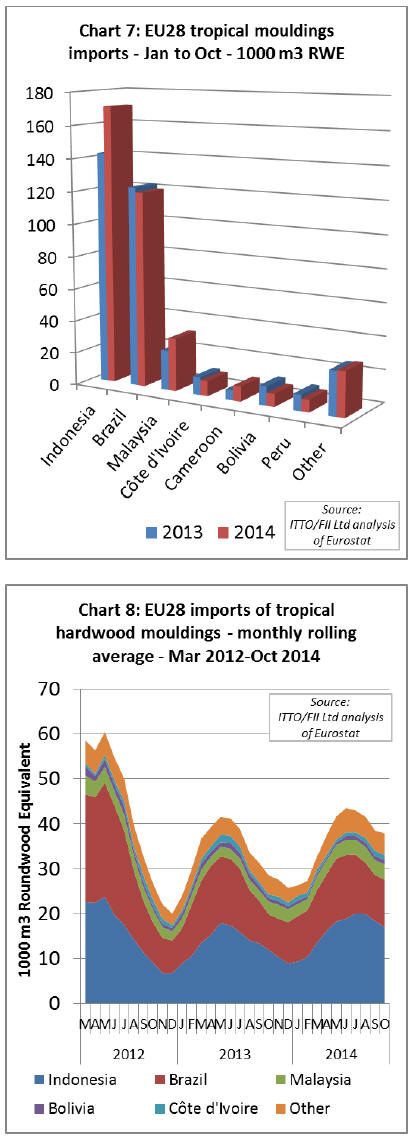
Brazilian decking products were the target of a
Greenpeace campaign in Europe in 2014. Several large
European retailers put their sales of ipe decking on hold
following Greenpeace allegations that legal documentation
provided by Brazilian exporters does not meet EUTR
requirements.
According to a recent report by the European Timber
Trade Federation, investigations by the Belgian EUTR
authorities and customs into six containers of ipe decking
imported into Belgium alleged by Greenpeace to derive
from an illegal source were still ongoing in December
2014. The Belgian authorities were awaiting „clarity‟ on
legality documentation from Brazil and the Belgian
importers.
Monthly data for 2014 reveals the usual steep rise in EU
imports of moulding and decking products during the
second quarter, levelling off in June/July and then
declining towards the end of the year (Chart 8).
Overall the European summer decking season in 2014 was
marginally better than in 2013 when imports were
seriously undermined by over-stocking from the previous
year.
Although European importers are quite optimistic about
demand for decking in the coming 2015 season, there are
concerns that higher prices for tropical hardwood decking
will lead to increased substitution by alternative products,
notably wood plastic composites.
Indonesian bangkirai exporters are quoting significantly
higher prices this year due to rising log and labour costs.
The relative weakness of the euro against the dollar is a
further disincentive for European importers. Supplies of
Brazilian decking are also expected to be limited as more
of this product is diverted to the U.S. market.
|